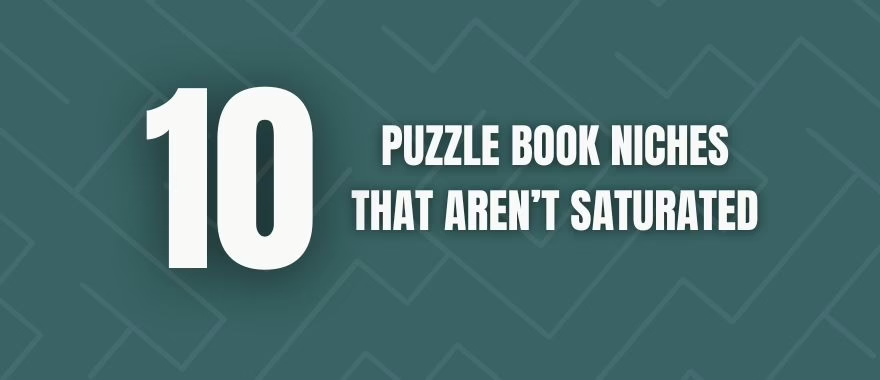You might have a great puzzle book, but if it speaks too many languages, it can get lost in a sea of options. When you narrow your focus to a specific group, your book stands out. Picture a word search book for seniors that’s made with huge letters so they don’t need to grab their eyeglasses or a dog-themed sudoku book for customers that are obsessed with animals. Choosing a niche builds a stronger bond with your target readers. It helps your work feel custom-made just for them.
Focusing on a specific niche may sound risky at first. You might think that the more people you aim for, the more sales you will get. That is not always true. When you try to cater to everyone, your puzzle book can feel unfocused and will have to compete with millions of other books. Instead, pick a crowd that you know well. Let your experience and insights lead you. This approach makes marketing easier and gives you a much smaller pool of books that you need to compete with.
Find Your Niche
Start by asking yourself who really loves puzzles. Your own experience can guide you. Do you know someone who enjoys brain teasers after a long day? Can you think of groups that appreciate a good mental challenge? Write down a list of ideas. Brainstorm topics that suit puzzles best. You might consider themes like history, pop culture, or even nature. Remember, the goal is to find people that are passionate about a specific topic and cater your product to things that they would find interesting.
Once you decide on a crowd, dive into their world. Read reviews of other puzzle books that target the same group. See what fans are saying. Watch social media groups or forums where these readers gather. Ask questions to get a better sense of their needs. The more you know about your audience, the better your book will connect with them.
Your niche also guides the kind of puzzles you include. It might mean offering puzzles with larger text or making sure the difficulty is just right for that group. When readers see a puzzle book that feels tailored for them, they feel more confident in making a purchase. This strong connection can lead to positive word of mouth and repeat buyers.
Design for Your Audience
Once you know your niche, design your book to hit home. A clear design shows your readers that every detail has been thought of. Look at the way you arrange your puzzles. Are they easy to follow for the audience you chose? For example, if you target older readers, use a simple layout and big fonts. If your puzzle book is for kids, add fun doodles and bright colors.
Take a look at your cover. It should immediately connect with the people you want to reach. A good cover uses clear images and text that directly matches the niche. It’ll have images that interest your target group or show visuals that make them smile. A strong cover can make or break a book.
You might also structure the puzzles to build gradually in difficulty. Start with simple ones and then add a few that require more thought. This keeps readers engaged and helps them feel a sense of progress. It works like this: when someone sees that your puzzle book matches their pace, they are more likely to trust it over a generic one.
Make sure the instructions and any extra help you offer are written in plain language. Your readers do not need to decipher complicated words. Every page should be clear and friendly. This careful design shows that you understand your audience and value their time.
Market to Your Niche
Your puzzle book might be amazing, but if the right people do not see it, you won’t see any sales. Marketing is key. Build your message around the niche you choose. Think about where your ideal customer hangs out online. If your book is for a certain age group or interest, ask yourself what blogs, websites, or social media pages they visit. Join those spaces, check their rules and, if allowed, share your best products with them.
Try to speak simply and honestly in your ads and posts. Write in a way that helps readers feel like they are getting advice from a friend who knows the ins and outs of puzzles. Have you noticed that some readers complain about puzzles that are too hard or too simple? Address these points in your marketing. Talk about how your book offers the right blend of fun and challenge.
Don’t stop at social media. Reach out through email newsletters, write blog posts, or even make short videos. Share your own journey in creating a puzzle book that fits a need. Let your audience know you understand them and their passion.
Refining Your Strategy
Once you start making sales, look at which parts of your approach bring the most interest. This can be as simple as keeping an eye on your online store’s analytics. Ask yourself if the puzzles, design, and marketing are meeting the unique needs of your audience. You can try small tweaks over time. For example, if you see that a different cover design gets more clicks, give that design preference for your upcoming books.
Keep communication open. Ask your customers what they like best and what they would change. Direct feedback is your best guide. Take a few minutes to read reviews and emails. Look for common themes in their responses. Then make changes that help your puzzle book run smoother for the people who value it most.
It is a learning process where you feel your way forward. Check that your instructions are easy to understand and that your book is designed well. Never stop improving your style. Look over your design and see if it fits the group you planned for. Every small change can boost sales. Your understanding of the niche grows with each update and interaction with your readers.
Easiest Way to Make More Puzzle Books Sales
Just because you’re niching down, doesn’t mean you have to stay in that one niche only. If you’re a pet lover, you can focus books on dogs, cats, kangaroos, etc. Give each niche enough attention to see if there’s an audience for it, and don’t be afraid to change niches when there isn’t. You’ll still want to maintain high quality standards, so don’t try to cover every niche on earth. For one, it’s literally impossible, and two, you’ll wear yourself thin very quickly. Focus on your passions and your interests and it’ll be a whole lot easier to create products and marketing content.






